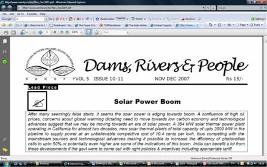Punjab
"India: Water Need to be Double the Supply in 20 Years" : Droplets, e-newsletter, Jan 2010
Posted on 27 Jan, 2010 12:33 PM
Monthly magazine-Dams, Rivers & People, Sep-Oct 2009, Oct-Nov 2009, Dec 2009 - Jan 2010
Posted on 25 Jan, 2010 12:56 PM
Direct seeding initiatives with paddy farmers in Punjab - PepsiCo India Holdings - Gurgaon
Posted on 17 Nov, 2009 05:58 PMWork taken up focussed on promoting direct seeding instead of transplantation in the paddy crop. As a result of this, about 30% reduction in water consumption was achieved covering about 1100 acres in 5 states. Farmers could also reduce their production costs by upto Rs.1400/acre.
Map depicting areas prone to flooding in India
Posted on 19 Aug, 2009 03:48 PMThis map shows the regions in the country that are regularly affected by floods.
The major flood prone regions are Punjab, Haryana, most of the Gangetic plains including Uttar Pradesh, North Bihar and West Bengal, the Brahmaputra valley, coastal Andhra Pradesh and Orissa, and South Gujarat.
Incidence of fluorosis: Map showing states affected by fluorosis in india
Posted on 19 Aug, 2009 12:44 PMThese two maps indicate the percentage of districts affected by fluoride, in each state of the country and also gives data of the range of fluoride concentration in drinking water in each state.
Water section from environment report of Punjab (2007)
Posted on 12 Aug, 2009 03:55 PMThis section on water from the Punjab State of the Environment Report has been presented in the attachment. In addition to the actions being taken up by the state for conservation of water resources and preservation of its quality, the following additions are recommended in the report–
Water Conservation
National water policy and state water policy of Assam, Himachal Pradesh, Karnataka, Kerala, Madhya Pradesh, Maharashtra, Punjab, Rajasthan and Uttar Pradesh
Posted on 02 Jun, 2009 10:33 AMNational water policy, 2002 Read policy
National water policy, 1987 Read policy
The living wisdom: using local well driller knowledge to construct digital groundwater data bases
Posted on 14 May, 2009 12:39 PMIn the absence of groundwater instrumentation networks in India, the knowledge of local well drillers about the location, quality, etc of groundwater aquifers is invaluable.
Hydroelectric power projects & climate change: A case study of Ravi basin in Himachal Pradesh
Posted on 09 Apr, 2009 11:34 AMThe following is a paper by Dr. Mohinder Slariya based on data collected during his Ph.D work. The work contains data sourced from the India Water Portal, and aims to illustrate local area climate changes with the development of hydroelectric projects. The abstract of the paper has been quoted below, with the full paper available as a download!
Abstract
Dams have had serious impacts on the lives, livelihoods, cultures and spiritual existence of indigenous, tribal and illiterate people, moreover on the physical environmental conditions and on the biodiversity of the area concerned. The dam related developmental activities in Ravi catchment area have been threatening the biodiversity in the whole catchment. There are more than 50 rivulets in the Ravi catchment and on which more than 70 power projects have been planned by the government by putting biodiversity at the stake. Developmental activities have unintentionally produce weather and climate modifications on a larger scale and threaten the existing biodiversity. Such developmental activities have been started day back in 1980s in Ravi basin with the installation of Baira Suil Power Project and today it has covered all most all Ravi basin starting from interstate broader of Jammu & Kashmir, Punjab and Himachal Pradesh and engulfed the green cover of the area. Because of this extinction the catchments area is experiencing drastic climatic changes, because of 100 km reservoirs of Shahpur Kandi (125MW), Thein Dam (600MW), Chamera-I (540MW) and Chamera-II (300 MW) and tunnelization of Ravi in 19.38 kms with a dia of 7 to 9 meters and 102 meters high surge shafts with 15.5 meters dia and underground power houses of Chamera-I & II and dry Ravi in almost all its natural route (27 kilometers in Chamera I & II). In this dry region there is a tremendous increase in the temperature and there is no timely and usual rain in the basin after the installation of power projects.
Contents of the latest SANDRP newsletter : Solar power boom and many more stories
Posted on 03 Jan, 2008 01:01 AM The latest issue of SANDRP's newsletter contains the following: Solar Power Boom Bihar Floods 2007: Some lessons for everyone Power Options: New Look Required 11th Five Year Plan: Why it may not a
The latest issue of SANDRP's newsletter contains the following: Solar Power Boom Bihar Floods 2007: Some lessons for everyone Power Options: New Look Required 11th Five Year Plan: Why it may not a